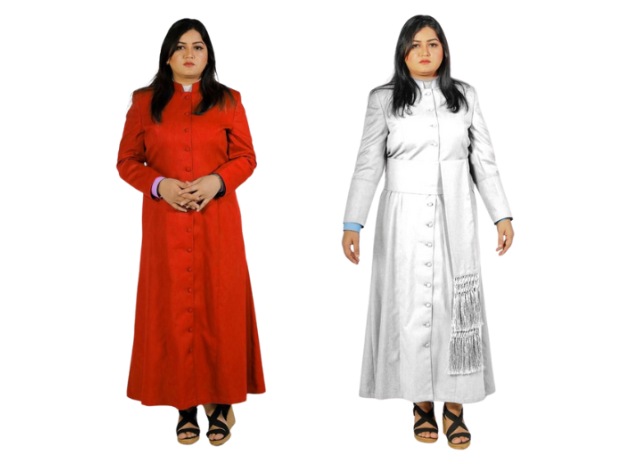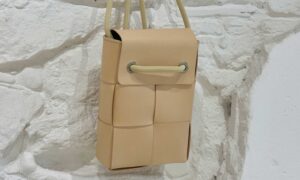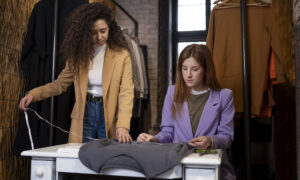The world of religious attire is changing, and one of the most exciting trends in recent years is the growing popularity of women clergy robes. As female clergy members step into leadership roles across various religious denominations, there has been a noticeable shift in the way priest attire is designed and worn. Women clergy members are challenging the traditional designs of priest attire, creating a shift that impacts how priests, both male and female, dress for their religious duties. One of the biggest changes has been the design and use of women clergy robes, which have a big effect on how priest attire is seen in the modern world. This article will explore how women clergy robes have impacted priest attire fashion, making it more inclusive, comfortable, and stylish for women in the clergy.
Gender Equality in Clergy Fashion: A Step Towards Inclusivity
One of the most important impacts of women clergy robes is the push for gender equality in religious attire. For a long time, priest attire was designed with only male clergy members in mind. Women, however, have been part of the clergy for a long time, and they deserve robes that reflect their role and leadership.
- Challenging Gendered Attire: Women clergy robes are designed to be more inclusive by challenging the gendered designs of traditional priest robes.
- Breaking Traditions: By wearing robes designed specifically for women, female clergy members are breaking old traditions that did not take their needs and comfort into account.
- Promoting Equality: As more women enter the clergy, their robes serve as a symbol of gender equality, showing that women can lead just as well as men in religious spaces.
Women clergy robes are important for creating more equal representation within religious communities, and they show that female clergy members are just as capable and important as their male counterparts.
Modernization of Traditional Attire: Breaking Away from Gendered Norms
As society changes, so does the way we dress. Traditional priest attire has remained mostly unchanged for centuries. However, women clergy robes are helping to modernize the look and feel of priest attire.
- New Styles: Women clergy robes often come in new, modern styles that are different from traditional robes. These robes are more comfortable and stylish, allowing women to feel confident while fulfilling their religious duties.
- Changing the Narrative: The introduction of female-specific clergy robes challenges the idea that priests must only Wear old-fashioned, unflattering clothing. These robes show that priest attire can be both sacred and fashionable.
- Incorporating Comfort: Today’s women clergy robes are designed with comfort in mind. They use materials that breathe and allow movement, making it easier for women to perform their roles in the church.
Modern Divinity Clergy Wear Cassocks are not just about fashion. They’re about making sure that women clergy members feel comfortable and confident in their attire. This modernization allows for more flexibility in how women express themselves through their clothing.
Tailoring and Comfort: The Practicality of Female Clergy Robes
One of the most important aspects of any clergy robe is comfort. For years, men’s robes were the model for all clergy attire, but these often did not suit women’s bodies or needs. Women clergy robes have changed this by focusing on fit, comfort, and ease of movement.
- Tailored Fit: Unlike traditional robes that may be too baggy or ill-fitting, women clergy robes are designed to fit the female body more comfortably. They are tailored to provide the perfect fit while allowing for ease of movement.
- Comfortable Fabrics: The fabrics used in women clergy robes are chosen to be soft, breathable, and comfortable. Many robes are made from materials that help clergy members stay cool during long services.
- Adjustable Features: Some women clergy robes come with adjustable features, such as cuffs, waistbands, or necklines, allowing each wearer to customize the robe to fit their body.
Comfort is a big part of why women clergy robes are becoming more popular. They allow women to focus on their work without worrying about feeling restricted or uncomfortable in their clothing.
Cultural Shift in Religious Attire: A New Era of Modesty and Respect
As more women take on leadership roles in religious settings, there has been a cultural shift in how we view modesty and respect in religious attire. Women clergy robes fit perfectly into this shift, balancing the need for modesty with the desire for personal style.
- Balancing Modesty and Style: Women clergy robes are designed to be modest, which is important in many religious traditions. However, these robes also allow women to express their individual styles in a respectful way.
- Respect for Tradition: While women clergy robes are modern in their design, they still honor the long-standing traditions of priest attire. This respect for tradition shows that women are part of the sacred history of the clergy, even as they make changes to it.
- Reflection of Leadership: Women in the clergy often lead by example. Their robes reflect their leadership roles, showing respect for their positions and the people they serve.
The shift in religious attire is important for recognizing the contributions of women clergy members while maintaining respect for tradition. Women clergy robes reflect both modesty and the evolving role of women in the church.
Broader Influence on Priest Fashion: How Women Are Leading the Change
The influence of women clergy robes goes beyond just female clergy members. These robes are having an impact on the broader fashion trends for priests of all genders.
- Changing Priest Attire: The rise of women clergy robes has pushed for changes in how all clergy members dress. Men’s robes, too, are becoming more modern and comfortable, as the clergy attire industry adapts to the changing times.
- Fashion for All Genders: The focus on women clergy robes has also opened the door for more variety in priest attire. Both men and women can now choose robes that fit their personal style, making priest attire more inclusive for everyone.
- Leading the Way: Women are leading the way in priest attire fashion by showing that robes can be functional, comfortable, and stylish. Their influence is changing the way people think about religious clothing for both genders.
Women clergy robes are not just about making women feel comfortable—they are also about making priest attire more inclusive and modern for everyone. Women are pushing the boundaries of what clergy attire can be, and their impact is being felt across all denominations.
Influence of Feminist Movements on Clergy Fashion
Feminism has had a big impact on many aspects of society, and clergy attire is no exception. The feminist movement has helped push for change in how women are treated in religious settings, and women clergy robes are a part of that change.
- Feminist Principles: Feminist movements have fought for women’s rights in many areas, and religious attire is no exception. Women clergy robes reflect the idea that women deserve to have clothing that fits their needs and shows their authority.
- Equal Representation: Feminist movements have worked to ensure that women have the same rights and opportunities as men. Women clergy robes help represent this equality in the church by giving women robes that fit their role as clergy members.
- Challenging Traditional Norms: Feminist movements challenge traditional gender norms, and women clergy robes do the same by offering women a choice in how they dress for their religious duties.
The feminist movement has been an important part of the evolution of women clergy robes, helping to make priest attire more inclusive and equal for everyone.
Cultural and Denominational Variations in Women’s Clergy Robes
Not all churches and denominations are the same, and this is also true for clergy attire. Women clergy robes vary from one denomination to another, reflecting the diversity of religious practices around the world.
- Denominational Differences: Different religious traditions have different ideas about what clergy members should wear. Women clergy robes vary in style, color, and design depending on the denomination.
- Cultural Influences: Cultural differences also influence the design of women clergy robes. In some cultures, women may wear more elaborate robes with intricate details, while in others, robes may be simpler and more traditional.
- Custom Design Options: Some women clergy robes can be custom-made to fit the specific needs of a denomination or culture. This customization helps ensure that the robes are respectful of both tradition and cultural preferences.
Understanding the cultural and denominational differences in women clergy robes helps to appreciate how diverse and rich the traditions of the church can be.
Breaking Away from Formality: Comfort and Flexibility in Design
While formality is often important in religious settings, many clergy members today are seeking more flexibility and comfort in their attire. Women clergy robes have responded to this need by offering less formal options that still maintain respect for tradition.
- Less Formal Designs: Some women clergy robes are designed to be less formal, allowing clergy members to move freely and comfortably while still looking respectful.
- Flexible Features: Many robes now come with flexible features such as adjustable sleeves, longer or shorter hems, and more breathable materials.
- Comfortable and Practical: These robes allow women clergy members to focus on their duties without worrying about restrictive clothing.
The move towards less formal and more flexible women clergy robes reflects a desire for comfort while still maintaining a respectful appearance.
Design Innovation and Customization: Crafting Robes That Fit Every Clergy Woman
As women clergy robes become more popular, there has been an increased focus on design innovation and customization.
- Customized Robes: Many companies offer women clergy robes that can be tailored to fit the specific needs of the wearer. This allows each clergy member to have a robe that fits them perfectly and suits their individual style.
- Innovative Designs: Designers of women clergy robes are constantly coming up with new ways to improve the fit, look, and feel of these robes. From breathable fabrics to adjustable features, the options are endless.
- Personalized Style: Many women clergy members are looking for robes that reflect their personality and role in the church. Customization allows them to choose colors, fabrics, and details that speak to their individuality.
Design innovation in women clergy robes is helping to ensure that each robe is as unique as the clergy member wearing it.
How Female Clergy Robes Are Shaping All Religious Attire
The impact of women clergy robes is not limited to one denomination or religious tradition. These robes are influencing priest attire across all faiths and denominations.
- Wide Influence: The designs and trends that started with women clergy robes have spread across different denominations, influencing how clergy members of all genders dress.
- Inspiring Change: As more women clergy members wear robes that are tailored to their needs, they are inspiring similar changes in priest attire across religious traditions.
- Shared Ideas: Women clergy robes have helped foster a more open and inclusive approach to clergy fashion, where different faiths are learning from one another and adopting new styles.
The cross-denominational influence of women clergy robes shows how powerful the impact of these robes has been in changing how priests, regardless of gender, dress for their sacred duties.
Conclusion
The rise of women clergy robes has significantly transformed priest attire, fostering positive changes for clergy members of all genders. These robes champion gender equality, modernize traditional clothing styles, and prioritize comfort, all while reflecting the evolving role of women in religious leadership. As women clergy robes continue to evolve, they will undoubtedly continue to shape the future of clergy fashion, promoting inclusivity and innovation. The growing focus on customization and design innovation ensures that clergy attire will become more personalized and functional, paving the way for a more inclusive and flexible approach to religious dress for generations to come.



































